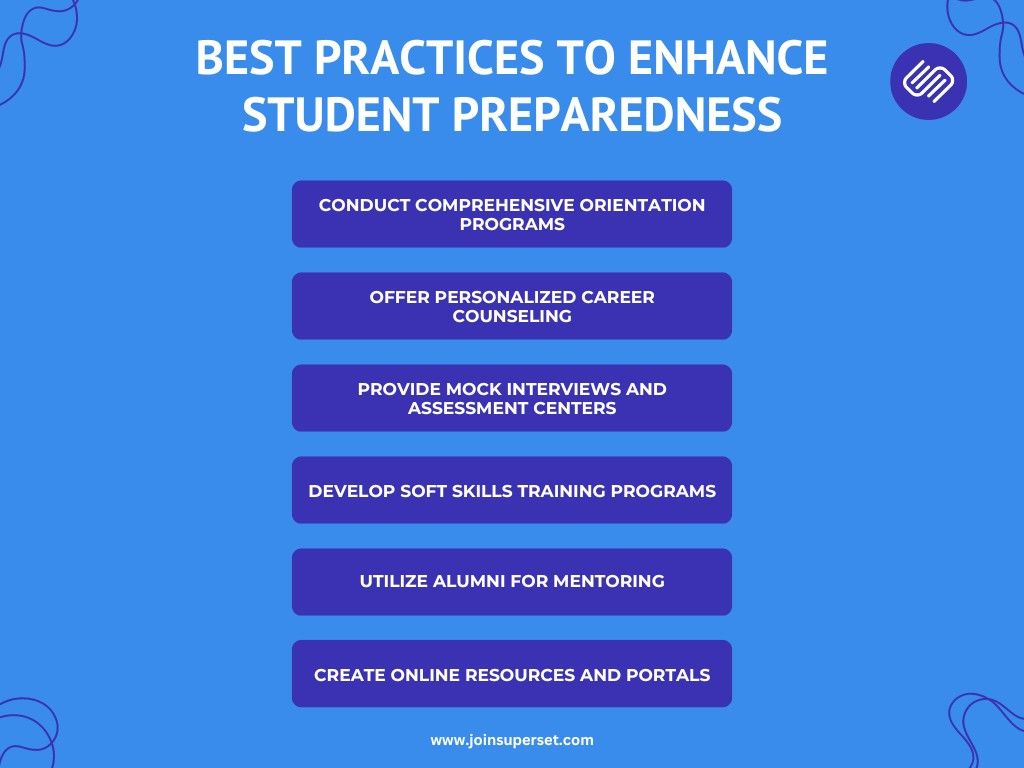Building a robust campus placement team ensures high placement rates and fosters successful student careers. A well-structured placement team can significantly enhance the effectiveness of the placement process, making it smoother, more efficient, and more beneficial for both students and employers. This blog will explore over 20 tips and best practices for constructing a strong campus placement team, focusing on strategies that include utilising campus placement software, automating campus placement processes, and leveraging online campus placement tools.
1. Define Clear Roles and Responsibilities
The first step in building an effective campus placement team is to define clear roles and responsibilities. Each team member should have a specific role, such as Placement Coordinator, Industry Liaison Officer, Data Analyst, Student Relations Manager, or Events Coordinator. This clarity ensures that all tasks are covered and that team members can focus on their specific duties.
2. Recruit a Diverse Team
Diversity within the placement team can bring a range of perspectives and ideas, leading to innovative solutions. Include members from various academic backgrounds and professional experiences to cover all aspects of the placement process comprehensively.
3. Provide Comprehensive Training
Training is crucial for keeping the team updated on industry trends, recruitment processes, soft skills, and the use of campus placement software. Regular training sessions ensure that all team members are equipped with the necessary knowledge and skills to perform their roles effectively.
4. Leverage Technology
The use of advanced campus placement software can streamline operations, manage data efficiently, and track progress. Software solutions like online campus placement software help automate various tasks, such as resume screening, interview scheduling, and data analysis, making the process more efficient and less time-consuming.
5. Establish Strong Communication Channels
Maintaining open and consistent communication within the team is vital. Regular meetings, updates, and the use of collaborative tools like Slack or Microsoft Teams can help keep everyone informed and aligned with the team’s goals.
6. Foster Industry Relationships
Building and maintaining strong relationships with industry partners is essential for successful placements. Regular interactions, visits, and networking events with industry representatives can open up more opportunities for students and provide insights into current hiring trends.
7. Focus on Data-Driven Decisions
Using data analytics to track performance and identify trends can significantly improve the placement process. Regularly reviewing placement statistics and feedback helps in making informed decisions and refining strategies.
8. Encourage Student Involvement
Involving students in the placement process through committees or ambassador programs can increase engagement and ensure that the team understands student needs. This involvement can also help in gathering feedback and making necessary adjustments.
9. Organize Skill Development Workshops
Conducting workshops on resume writing, interview skills, personal branding, and other essential skills prepares students for placements. These workshops can be organized in collaboration with industry experts to provide practical insights.
10. Promote Continuous Learning
Encourage team members to stay updated with the latest industry trends, recruitment practices, and technological advancements through courses and certifications. This continuous learning ensures that the team is always at the forefront of best practices.
11. Implement Feedback Mechanisms
Collecting feedback from recruiters, students, and team members after each placement cycle is essential for continuous improvement. Use this feedback to identify areas of improvement and make necessary adjustments to the placement process.
12. Develop a Strategic Plan
Creating a detailed strategic plan outlining the goals, timelines, and key activities for the placement season is crucial. Ensure that this plan aligns with the university’s overall objectives and includes contingencies for unexpected challenges.
13. Create a Marketing Strategy
Develop a marketing plan to promote the university’s strengths and the placement program to potential recruiters. Use social media, university websites, and newsletters to highlight successful placements and student achievements.
14. Foster a Collaborative Environment
Promote teamwork and collaboration within the placement team. Encourage the sharing of ideas and best practices, and create an environment where team members feel valued and motivated.
15. Establish Metrics for Success
Define clear metrics to measure the success of the placement program, such as placement rates, student satisfaction, and employer feedback. Regularly review these metrics to track progress and make necessary adjustments.
16. Build a Strong Alumni Network
Engage alumni in mentoring programs, networking events, and recruitment drives. Alumni can provide valuable industry insights and job opportunities, enhancing the placement program.
17. Host Regular Employer Engagement Events
Organize job fairs, industry talks, and networking events to facilitate interactions between students and employers. These events provide students with opportunities to network and learn about different industries.
18. Ensure Transparency and Accountability
Maintaining transparency in the placement process and holding team members accountable for their responsibilities and performance is essential. This transparency builds trust among students, employers, and team members.
19. Promote Inclusivity
Ensure that the placement process is inclusive and caters to the needs of all students, regardless of their background or academic performance. This inclusivity can be achieved by offering personalized support and resources.
20. Utilize Peer Learning
Encourage team members to learn from each other by sharing experiences and insights during team meetings and training sessions. Peer learning fosters a collaborative environment and helps in the continuous improvement of the team.
21. Create a Supportive Environment
Provide emotional and professional support to team members to keep them motivated and engaged. A supportive environment ensures that team members can perform their roles effectively and efficiently.
22. Document Processes and Procedures
Maintain comprehensive documentation of all placement processes and procedures. This documentation ensures consistency and facilitates the training of new team members.
23. Celebrate Successes
Acknowledge and celebrate the achievements of the team and the students. Celebrating successes boosts morale and motivation, encouraging the team to continue striving for excellence.
24. Adapt to Changes
Be flexible and adapt to changes in the industry, technology, and student needs. Continuously review and update the placement strategy to ensure it remains relevant and effective.
25. Encourage Innovation
Promote a culture of innovation within the team by encouraging new ideas and approaches to improve the placement process. Innovation can lead to more efficient and effective practices, enhancing the overall success of the placement program.
Leveraging Technology for Campus Placements
One of the key factors in building a robust campus placement team is leveraging technology effectively. The use of campus placement software can significantly enhance the efficiency and effectiveness of the placement process. Here are some ways in which technology can be utilized:
Automate Campus Placement
Automating various aspects of the campus placement process can save time and reduce errors. Campus placement software can automate tasks such as resume screening, interview scheduling, and data management. This automation allows the team to focus on more strategic activities, such as building industry relationships and preparing students for interviews.
Online Campus Placement
The shift to online campus placement has been accelerated by the COVID-19 pandemic. Online campus placement tools enable virtual interviews, online assessments, and digital resume submissions. These tools make the placement process more accessible and convenient for both students and recruiters.
Online Campus Placement Software
Using online campus placement software like Superset can streamline the entire placement process. These software solutions offer features such as applicant tracking, interview scheduling, data analytics, and reporting. By centralizing all placement-related activities, the software ensures that the process is efficient and well-organized.
Benefits of Campus Placement Software
- Efficiency: Automates repetitive tasks, saving time and reducing errors.
- Data Management: Centralizes data, making it easy to track and analyze.
- Communication: Facilitates communication between the placement team, students, and recruiters.
- Reporting: Provides detailed reports on placement metrics, helping in data-driven decision-making.
Enhancing Student Preparedness for Campus Placements
Preparing students effectively for campus placements is a critical component of a successful placement program. Ensuring that students are well-prepared not only improves their chances of securing jobs but also reflects positively on the institution. Here are some best practices to enhance student preparedness:

- Conduct Comprehensive Orientation Programs
Start with comprehensive orientation programs that introduce students to the placement process, expectations, and available resources. These programs can provide an overview of what students need to do to be successful in their job searches.
- Offer Personalized Career Counseling
Personalized career counselling can help students identify their strengths, weaknesses, and career aspirations. Career counselors can guide you in choosing the right career path, preparing resumes, and practising interview skills.
- Provide Mock Interviews and Assessment Centers
Organize mock interviews and assessment centres to give students hands-on experience with the types of interviews and assessments they will face. These sessions can help students build confidence and improve their performance.
- Develop Soft Skills Training Programs
Soft skills are increasingly important in today’s job market. Offer training programs that focus on communication skills, teamwork, problem-solving, and leadership. These programs can help students develop the interpersonal skills needed to succeed in the workplace.
- Utilize Alumni for Mentoring
Alumni can be a valuable resource for mentoring current students. Set up a mentoring program where alumni can share their experiences, provide advice, and offer insights into the industry. This connection can give students a realistic view of their chosen career paths.
- Create Online Resources and Portals
Develop online resources and portals where students can access information about the placement process, job listings, resume templates, interview tips, and other career-related content. An online portal can serve as a one-stop shop for all placement-related needs.
Maintaining Long-Term Employer Relationships
Building and maintaining long-term relationships with employers is crucial for the success of any campus placement program. Strong employer relationships ensure a steady flow of job opportunities for students and help in establishing the institution’s reputation in the industry.
- Regular Communication and Updates
Keep employers informed about the latest developments at the institution, including changes in academic programs, new facilities, and student achievements. Regular communication helps in keeping the relationship active and engaged.
- Organize Employer Appreciation Events
Host events to appreciate and recognize the contributions of employers to the placement program. These events can include awards, networking sessions, and panel discussions, providing an opportunity to strengthen the bond with employers.
- Tailor Placement Activities to Employer Needs
Understand the specific needs and requirements of employers and tailor placement activities accordingly. Customizing activities to meet employer expectations can lead to higher satisfaction and repeat engagements.
- Involve Employers in Curriculum Development
Invite employers to participate in curriculum development and review processes. Their input can ensure that the academic programs are aligned with industry needs, making graduates more employable.
- Provide Post-Placement Support
Offer support to employers and graduates even after the placement process is complete. This support can include follow-up meetings, feedback sessions, and assistance with onboarding. Providing post-placement support demonstrates a commitment to the success of both employers and graduates.
Conclusion
Building a robust campus placement team requires a strategic approach, effective use of technology, and a focus on continuous improvement. By defining clear roles, leveraging campus placement software, fostering industry relationships, and promoting a collaborative environment, universities can enhance their placement programs and ensure successful careers for their students. The tips and best practices outlined in this blog provide a comprehensive guide for creating an efficient and effective campus placement team that can adapt to the ever-changing demands of the job market. Utilizing technology to automate campus placement processes and leveraging online campus placement tools can significantly enhance the efficiency and success of the placement program. With a strong and well-organized placement team, universities can ensure that their students are well-prepared for the job market and achieve higher placement rates.








